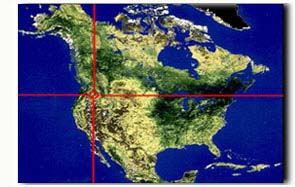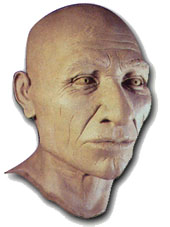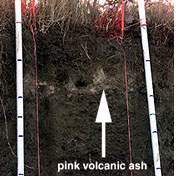 (continued...)
Within days the report came back. Kennewick Man was a whopping 9,500 years old, give or take a few hundred years. These were not the oldest remains ever found in the state. Washington's oldest human remains (found along the Snake River) have been dated to about 10,300 years old . But those were only partial skeletons. Kennewick Man had one of the most complete skeletons found on this continent for its age. Scientists were ecstatic and eager to conduct tests on the bones.
With modern technology, small fragments of DNA could be grown and evaluated for racial characteristics. The excellent condition of Kennewick Man's skull would easily enable a competent forensic artist to reconstruct the facial features of this mysterious man, and studies of his teeth and joints could tell about diet and stress. But only a small part of this information will now ever be known.
This data was gathered prior to the sudden confiscation of the body by the U.S. Army Corps of Engineers who had plans to turn the body over to Native American tribes post haste. Scientists around the globe were shocked. Some expressed disbelief that this could be true, knowing the scientific significance of the find.
Upon returning to the site, where more of the Kennewick Man's remains were found, scientists made an amazing yet expected discovery. In the strata of earth above the level where Kennewick Man was buried, a pink layer of volcanic ash was clearly visible. This layer, known as "tephra" is common in the area and has been dated to 6,800 years ago. This confirmed that Kennewick was old- very old.
During the time that the skeletal remains were locked away and inaccessible to researchers, several legal battles were being waged. The Native tribes, tired of their ancestral graves being examined and desecrated, wanted to bury Kennewick Man in a traditional ceremony. The scientific community, claiming that he was Caucasian, wanted to study the body for anthropological and archaeological information. The issue was complicated but the resolution came quick and final.
Outcries from scientists around the globe have recently made the U.S. Government open to a compromise. Talks are now being conducted on the possibility of digging up Kennewick Man again and performing such studies as would determine his racial origin But still there continues to be a drag from the governmental agencies involved.
We have located photographs of the facial reconstruction of Kennewick Man and present them here, with some enhancements, for your inspection.
UPDATE:
|

 Preliminary examination revealed a few surprises for a man of this great age. His height, five feet ten inches, was much taller than the similar skeletal remains of paleo-Indians and early Native Americans in the area. Also, his head was not flattened on the back, as is the case with most "Indian" remains (due to being bound against a cradle board during infancy). His joints appeared to lack degeneration, meaning his life's work involved little heavy lifting. His teeth were in relatively good condition, meaning he ate mostly meat or raw plants rather than stone ground meal.
Preliminary examination revealed a few surprises for a man of this great age. His height, five feet ten inches, was much taller than the similar skeletal remains of paleo-Indians and early Native Americans in the area. Also, his head was not flattened on the back, as is the case with most "Indian" remains (due to being bound against a cradle board during infancy). His joints appeared to lack degeneration, meaning his life's work involved little heavy lifting. His teeth were in relatively good condition, meaning he ate mostly meat or raw plants rather than stone ground meal. U.S. Magistrate Judge John Jelderks admonished the U.S. Corps of Engineers for their premature and presumptive action, and suggested that they examine more deeply whether the remains were possibly not those of a Native American. He cited them for having insufficient proof to make their claim and warned against turning over the remains prior to more in-depth examination of Kennewich Man.
U.S. Magistrate Judge John Jelderks admonished the U.S. Corps of Engineers for their premature and presumptive action, and suggested that they examine more deeply whether the remains were possibly not those of a Native American. He cited them for having insufficient proof to make their claim and warned against turning over the remains prior to more in-depth examination of Kennewich Man. In June of 1998 the Clinton Administration sided with the tribes and Kennewich Man's remains were buried in a ceremony that involved mixing the bone fragments of Kennewich Man with various traditional Native burial artifacts. The action was swift and pre-empted the legal arguments that were pending. Could it be that someone in the U.S. government did not want either the publicity or the existence of a Caucasian male in North America circa 7,500 years BC. to be known. Further, a small speck of bone material at a lab in California (which was to determine DNA analysis) was seized by the government before any laboratory examination could begin. Why?
In June of 1998 the Clinton Administration sided with the tribes and Kennewich Man's remains were buried in a ceremony that involved mixing the bone fragments of Kennewich Man with various traditional Native burial artifacts. The action was swift and pre-empted the legal arguments that were pending. Could it be that someone in the U.S. government did not want either the publicity or the existence of a Caucasian male in North America circa 7,500 years BC. to be known. Further, a small speck of bone material at a lab in California (which was to determine DNA analysis) was seized by the government before any laboratory examination could begin. Why?